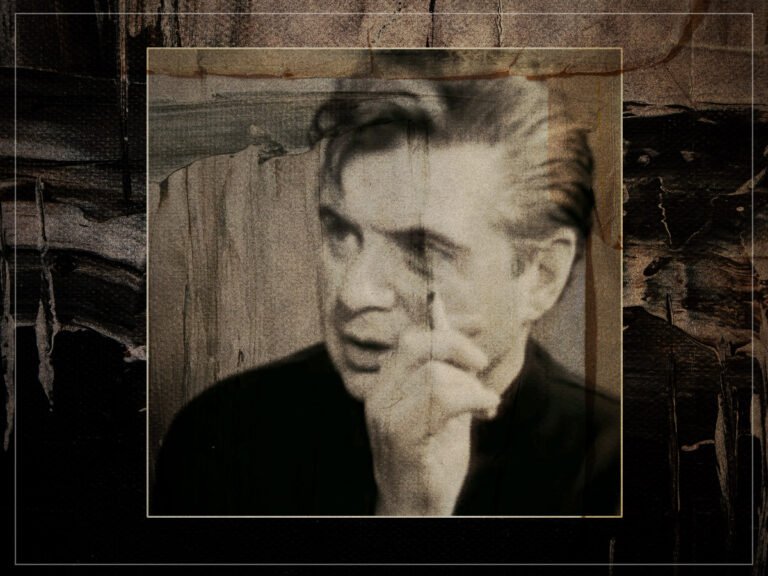
(Credits: Far Out / YouTube Still / Steve Johnson)
Irish artist Francis Bacon had always been intrigued by the male body. Whether it be his ex-boyfriends or his estranged father, painting the male figure was a predominant preoccupation and the primary subject of his works.
This fascination, beyond curiosity, was a dark sexual obsession, evident in the way he painted the men in a grotesquely warped and mangled fashion. This style never stopped, not even with the death of his long-time lover, George Dyer. The pair had a turbulent, violent, and outright toxic relationship, punctured by constant pushes and pulls. Dyer was a chronically depressed alcoholic, and Bacon wasn’t too dissimilar. It was his time in his art studio that was his only saving grace.
The story of how the two met is just as precarious as their relationship. Dyer, a thief in his pastime, attempted to burgle Bacon’s luxury flat, and shockingly, this awkward encounter at Bacon’s smashed window quickly turned into their intense love affair. But, as Bacon grew famous, Dyer disappeared into the wings of his life. Feeling excluded and suffering from his partner’s notoriety, Dyer found any possible way to turn the spotlight towards him. Multiple times, Bacon claimed that Dyer threatened to kill himself when Bacon tried to call it quits.
Spiralling into a never-ending doom of alcoholism and amphetamine abuse, Dyer eventually took his own life two nights before the opening of Bacon’s career-making retrospective show at the Grand Palais in Paris. Although the exhibition mostly featured paintings of Dyer, he hadn’t been invited, and Bacon was informed of his lover’s death just a few hours before the show started. Traumatised and shaken by the news, Bacon chose to attend anyway.
From that moment on, painting became even more of a therapeutic act for Bacon. In Isabelle Wallace’s essay ‘Trauma as Representation’, she asserts that trauma can only be “accessed in retrospect” because the traumatic moment is focused on the trauma response. Bacon finds his retrospective access through the repetitive nature of painting the same subject, Dyer, to process his suicide.
“The very act of living is violent.”
francis bacon
The most famous example of this style of painting can be seen in his series of triptychs in memory of Dyer. However, these don’t commemorate nor glorify Dyer like the paintings made when he was alive, which celebrated his virility. These are graphic, jarring postmortem snapshots taken right after his suicide.
Take a look at The Black Triptychs of 1973, for example. These three paintings show the moment before, during and after Dyer’s suicide and his transition from subject to object. In Triptych, May–June 1973, we are confronted with a harrowing scene: a slumped lump of flesh, without a head, bent over a lone toilet bowl in a black room. Dyer’s body is so compact, his face tucked between his legs, denoting his agony in his final moments. The dense black of the room he’s in illustrates exactly how he was feeling—lost and alone in the dark. We, as the viewers, are the only eyewitnesses and participants as he takes his last breaths.
In the second, his face is revealed, bloodied and pallid. A black shadow cast over Dyer, looking scarily similar to a winged beast, perhaps the angel of death, about to swallow him up. His death is marked by a singular dark lightbulb. Finally, Dyer, hunched over the toilet bowl, eyes shut in an almost peaceful way, seems to be vomiting blood, indicated by the red flecks of paint, the only colours in this monochromatic last canvas.
These paintings are riddled with pathos, through which Bacon’s remorse is felt. The choice of the triptych, a go-to for Bacon, is a religious style of painting composition rooted in Christian art. Triptychs would principally be used to show Christ’s death or ascension, so the choice to use this style likens Dyer to a holy figure for Bacon. The paintings are made on large canvases of 78 x 58 inches that make Dyer almost life-size, adding to the realism of the scene.
Bacon doesn’t sugar-coat anything in this triptych. Dyer’s death was just as volatile and brutal as his relationship with Bacon and his personal life. He once said, “I think that life is violent, and most people turn away from that side of it in an attempt to live a life that is screened. But I think they are merely fooling themselves. I mean, the act of birth is a violent thing, and the act of death is a violent thing. And, as you surely have observed, the very act of living is violent.”
Related Topics





